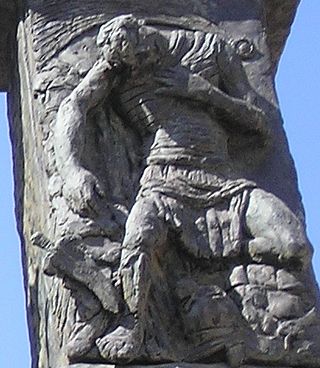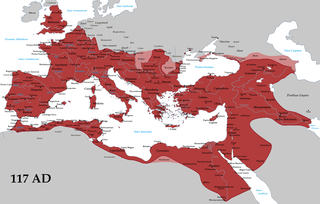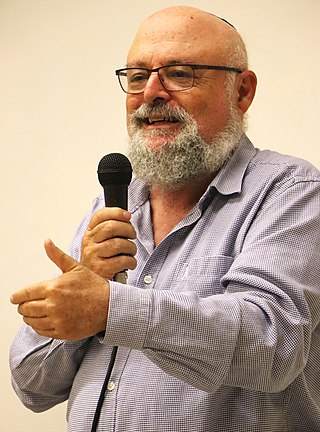Related Research Articles
The Book of Isaiah is the first of the Latter Prophets in the Hebrew Bible and the first of the Major Prophets in the Christian Old Testament. It is identified by a superscription as the words of the 8th-century BC prophet Isaiah ben Amoz, but there is evidence that much of it was composed during the Babylonian captivity and later. Johann Christoph Döderlein suggested in 1775 that the book contained the works of two prophets separated by more than a century, and Bernhard Duhm originated the view, held as a consensus through most of the 20th century, that the book comprises three separate collections of oracles: Proto-Isaiah, containing the words of the 8th-century BC prophet Isaiah; Deutero-Isaiah, or "the Book of Consolation",, the work of an anonymous 6th-century BCE author writing during the Exile; and Trito-Isaiah, composed after the return from Exile. Isaiah 1–33 promises judgment and restoration for Judah, Jerusalem and the nations, and chapters 34–66 presume that judgment has been pronounced and restoration follows soon. While few scholars today attribute the entire book, or even most of it, to one person, the book's essential unity has become a focus in more recent research.
The Book of Kings is a book in the Hebrew Bible, found as two books in the Old Testament of the Christian Bible. It concludes the Deuteronomistic history, a history of ancient Israel also including the books of Joshua, Judges, and Samuel.
The Sadducees were a sect of Jews active in Judea during the Second Temple period, from the second century BCE to the destruction of the Second Temple in 70 CE. The Sadducees are described in contemporary literary sources in contrast to the two other major sects at the time, the Pharisees and the Essenes.

The Messiah in Judaism is a savior and liberator figure in Jewish eschatology who is believed to be the future redeemer of the Jews. The concept of messianism originated in Judaism, and in the Hebrew Bible a messiah is a king or High Priest of Israel traditionally anointed with holy anointing oil.
Adherents of Judaism do not believe that Jesus of Nazareth was the Messiah or Prophet nor do they believe he was the Son of God. In the Jewish perspective, it is believed that the way Christians see Jesus goes against monotheism, a belief in the absolute unity and singularity of God, which is central to Judaism; Judaism sees the worship of a person as a form of idolatry, which is forbidden. Therefore, considering Jesus divine, as “God the Son”, is forbidden.

The Bar Kokhba revolt was a large-scale armed rebellion initiated by the Jews of Judea, led by Simon bar Kokhba, against the Roman Empire in 132 CE. Lasting until 135 or early 136, it was the third and final escalation of the Jewish–Roman wars. Like the First Jewish–Roman War and the Second Jewish–Roman War, the Bar Kokhba revolt resulted in a total Jewish defeat; Bar Kokhba was killed by Roman troops at Betar in 135, and the Jewish rebels who remained after his death were all killed or enslaved within the next year.

Most scholars who study the historical Jesus and early Christianity believe that the canonical gospels and the life of Jesus must be viewed within their historical and cultural context, rather than purely in terms of Christian orthodoxy. They look at Second Temple Judaism, the tensions, trends, and changes in the region under the influence of Hellenism and the Roman occupation, and the Jewish factions of the time, seeing Jesus as a Jew in this environment; and the written New Testament as arising from a period of oral gospel traditions after his death.

The Jewish–Roman wars were a series of large-scale revolts by the Jews of Judaea against the Roman Empire between 66 and 135 CE. The term primarily applies to the First Jewish–Roman War (66–73) and the Bar Kokhba revolt (132–136) which sought restoring Judean Independence that was lost since the Hasmonean civil war. Some sources also include the Diaspora Revolt (115–117), a campaign waged by the Jewish diaspora across the Eastern Mediterranean.

Israel Knohl is an Israeli Bible scholar and historian. He is the Yehezkel Kaufmann Professor of Biblical studies at the Hebrew University of Jerusalem and a Senior Fellow at Shalom Hartman Institute in Jerusalem. His books deal with the integration of scientific and archaeological discoveries with the biblical account, early Israelite beliefs, a survey of Israelite cult, and how and where the Israelites originated.

Isaiah 53 is the fifty-third chapter of the Book of Isaiah in the Hebrew Bible or the Old Testament of the Christian Bible. This book contains the prophecies attributed to the prophet Isaiah and is one of the Nevi'im. Chapters 40 to 55 are known as "Deutero-Isaiah" and date from the time of the Israelites' exile in Babylon.
The books of the New Testament frequently cite Jewish scripture to support the claim of the Early Christians that Jesus was the promised Jewish Messiah. Scholars have observed that few of these citations are actual predictions in context; the majority of these quotations and references are taken from the prophetic Book of Isaiah, but they range over the entire corpus of Jewish writings.
The servant songs are four songs in the Book of Isaiah in the Hebrew Bible, which include Isaiah 42:1–4; Isaiah 49:1–6; Isaiah 50:4–11; and Isaiah 52:13–53:12. The songs are four poems written about a certain "servant of YHWH". Yahweh calls the servant to lead the nations, but the servant is horribly abused by them. In the end, he is rewarded.
In Jewish eschatology Mashiach ben Yoseph or Messiah ben Joseph, also known as Mashiach bar/ben Ephraim, is a Jewish messiah from the tribe of Ephraim and a descendant of Joseph. The figure's origins are much debated. Some regard it as a rabbinic invention, but others defend the view that its origins are in the Torah.

The Disputation of Barcelona was a formal ordered medieval disputation between representatives of Christianity and Judaism regarding whether Jesus was the Jewish Messiah. It was held at the royal palace of King James I of Aragon in the presence of the King, his court, and many prominent ecclesiastical dignitaries and knights between Dominican Friar Pablo Christiani, a convert from Judaism to Christianity, and Nachmanides, a leading medieval Jewish scholar, philosopher, physician, kabbalist, and biblical commentator.

Sefer Zerubavel, also called the Book of Zerubbabel or the Apocalypse of Zerubbabel, is a medieval Hebrew-language apocalypse written at the beginning of the seventh century AD in the style of biblical visions placed into the mouth of Zerubbabel, the last descendant of the Davidic line to take a prominent part in Israel's history, who laid the foundation of the Second Temple in the sixth century BC. The enigmatic postexilic biblical leader receives a revelatory vision outlining personalities and events associated with the restoration of Israel, the End of Days, and the establishment of the Third Temple.

Gabriel's Revelation, also called Hazon Gabriel or the Jeselsohn Stone, is a stone tablet with 87 lines of Hebrew text written in ink, containing a collection of short prophecies written in the first person. It is dated to the late 1st century BCE or early 1st century CE and is important for understanding Jewish messianic expectations in the Second Temple period.
Second Temple Judaism is the Jewish religion as it developed during the Second Temple period, which began with the construction of the Second Temple around 516 BCE and ended with the Roman siege of Jerusalem in 70 CE.
Menahem ben Judah lived around the time of the First Jewish–Roman War and is mentioned by Josephus. He was the leader of a faction called the Sicarii who carried out assassinations of Romans and collaborators in the Holy Land.
Menahem ben Ammiel, or ben Amiel, is a character in apocalyptic Jewish texts, the future Messiah ben David of the Sefer Zerubbabel. He fights against Armilus.
In rabbinic Jewish eschatology, the Righteous Priest or Priest of Righteousness is a figure identified with one of the Four Craftsmen in a vision mentioned in the Book of Zechariah. He is found in the Talmud and Midrash.
References
- ↑ Steven Kepnes, ed. (1996). Interpreting Judaism in a Postmodern Age. NYU Press. p. 234. ISBN 9780814746752 . Retrieved 10 February 2014.
- ↑ Israel Knohl (2000). The Messiah Before Jesus: The Suffering Servant of the Dead Sea Scrolls . University of California Press. p. 70-74. ISBN 9780520215924 . Retrieved 30 January 2014.
The Messiah before Jesus: The Suffering Servant of the Dead Sea Scrolls.
- ↑ Raphael Patai (1979). The Messiah Texts. Wayne State University Press. p. 24, 122. ISBN 0814318509 . Retrieved 30 January 2014.